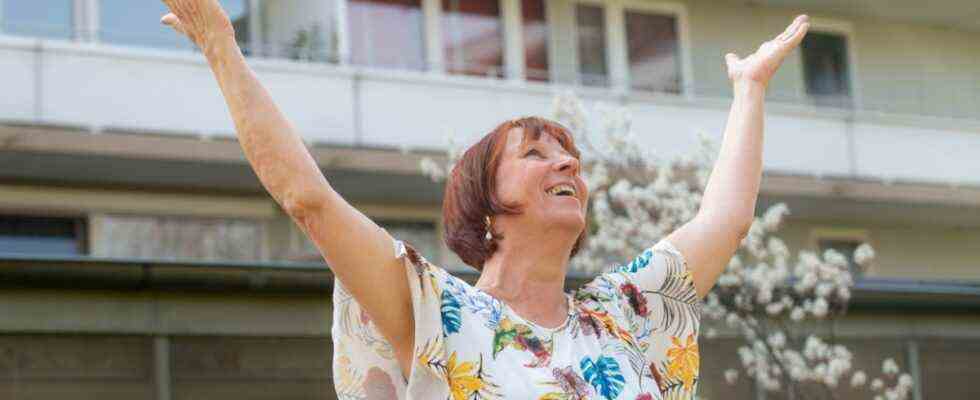“And now laugh freely!” Cornelia Leisch announces from her small zoom tile at the top left of the screen. After the first exercises were so little scary that one had already wondered where the decades-old aversion to laughter yoga actually came from, things are now getting serious. Free laugh? Something like “free Chinese” arrives in the brain and the simultaneous information that it is not available. You try to open your mouth, but nothing comes out. While more and more chicken chatter in various pitches comes out of the laptop’s speaker, you can’t even croak. Laugh? How does that even work? Have you ever laughed at all?
On Sunday, the European Professional Association for Laughter Yoga and Humor Training celebrates its 20th anniversary. To mark this occasion, you can take part in free online laughter training for one day. Further information is available at lachverband.org. Cornelia Leisch from Planegg is the chair of this institution, which has around 80 members from Germany, Switzerland and Austria. The Indian doctor Madan Kataria invented laughter yoga in 1995 in Mumbai, where he also founded the first laughter clubs. The idea spread around the world. The Munich laughing club in Westpark has been around for 17 years. Cornelia Leisch met him when she came back to Germany in 2001 from an unsuccessful emigration to Venezuela and the Dominican Republic. Neither sun, nor a gift shop on the beach, nor romantic love there had made her depression go away. This was only achieved through contact with laughter yoga.
At first she simply took part in the laughter meetings. “I went there, followed the instructions for the laughter exercises and didn’t have to do anything else. I didn’t have to present myself, didn’t have to say anything, no one had any expectations of me and after an hour of laughing in the group I felt like a different person. My Happiness flowed through my body. It was like a revelation.” This is how Leisch describes her first attempts at laughing. At some point she took over the management of the Westpark laughter club. Because of Corona, she is currently offering the laughter training via Zoom. As chairwoman of the association, she also organizes the training courses for laughter coaches.
According to the pure teaching one should fake laughter. But Cornelia Leisch is not that strict
Laugh on command? “Yes, there are many reservations,” says Leisch the day after the zoom training at Café Sickinger in Planegg. Many people think of artificial laughter, of falsehood, of cold laughter, says Leisch. “It took me five years to get the laugh club up and running in the West Park.” Precisely because many people would be frightened by the thought of such things. That’s why Leisch also changed direction in laughter training. The inventor Kataria issued the motto: Fake it until you make it. So: fake it until you actually laugh. But that’s exactly what many people don’t want, they just feel too funny about it.
Although Cornelia Leisch had also done her training using this method, she found the representative of another, gentler direction, who founded it in 2006, better: the Frenchman Sebastien Gendry – who, by the way, will also teach via Zoom on Sunday. He believes that you shouldn’t do anything artificial when it comes to laughter training. You don’t have to laugh, that’s how it is. “Laughter is in us and wants to get out anyway,” says Leisch. Therefore it will appear when the time is right. Many people have great inhibitions and many negative reviews in the back of their minds. The sentence “Don’t laugh so stupid!” or the topic of laughing at is present for many. Daring to laugh is not that easy.
The cackling of the old hands is contagious
Since Cornelia Leisch revealed this to the participants in a short introduction before the Zoom trial lesson, the experience of refusing to laugh is no reason to quickly click on “Leave”. You can just listen to how others laugh. Of course not all either. A closer look at the small tiles with faces reveals that some also look a bit confused. Others, however, are an invitation to laugh as well. For example Ralph, who laughs with such amusing lightness and without any stuttering, while leaning back in his chair, sometimes cheering a bit. Or Sonja on the bottom right with her cackling and giggling, who also doesn’t seem to have a problem letting out a laugh. These laughers are probably the “old hands” that Leisch is addressing. Namely those who have just completed a five-week laughter course. In the last hour, newcomers are always allowed to join. That’s us, who shy away from free laughter like a horse from an obstacle.
But until then it was definitely wonderful and totally relaxed, full of childlike lightness. Clap and finger exercises where you could funnily get confused – while saying “Ho ho ha ha ha” out loud. Breathing exercises with arms up and down, stand up and wiggle back and forth. There are four categories of exercises that make up a laughter workout: physical exercises, breathing exercises, positive reinforcers (yelling “Ouch, throwing your arms up”), and finally, the laughter exercises.
Before the meeting is over, you discover your funny bone just by looking at Ralph and – no, not at him, but laughing with him. He’s just great. And the advantage of Zoom is that nobody can watch so closely. What you then manage to do is not loud, free laughter, but rather suppressed laughter. Nevertheless, when everyone closes their eyes for a while afterwards, you actually feel them: the endorphins. A sweet little dose. Just enough to leave you wanting more.

